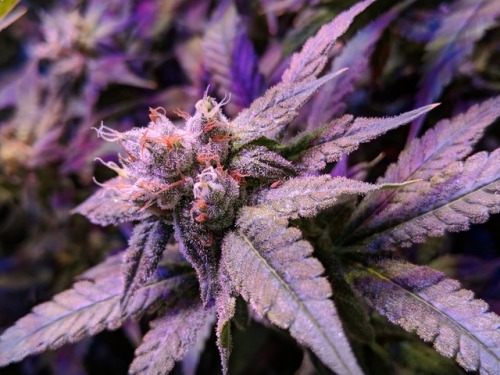Anthocyanins: Nature’s Purps
Oh, those Purps– the most stunning and elusive of cannabis flowers. Sure they’re a treat to behold, but what if I told you that purple varietals might actually have some unique properties that green flowers don’t? Could the molecules in question, then, play a role in the entourage effect?
Interest in cannabis’ polypharmaceutical potential grows as more and more literature emerges on cannabinoids and terpenes. As scientists begin to dig into cannabis’ mind-bogglingly complex phytochemistry, they’re realizing that there may be a whole lot more to the picture than just these two. Anthocyanin– a type of pigment molecule in the flavonoid family– might one day prove to be another important player in cannabis’ ever-broadening therapeutic potential.
Anthocyanins and Food Science
We often hear we need to “eat the rainbow” as nutrition lore has long touted the health benefits of including foods with red, blue, and violet pigments into our diets. Anthocyanins are the molecules that give these foods their color, and, according to in vitro (test tube) research, their apparent antioxidant benefits. The spectrum is vast: berries, red cabbage, pomegranate, eggplants, purple carrots, purple wheat, beets, et cetera– a veritable cornucopia of fruits, grains and vegetables. Many of them end up marketed as miracle-working “superfoods” that can reverse aging and prevent disease. Remember the acai bowl craze? Is that still a thing?
Anthocyanins have also garnered the attention of nutrition researchers all over the world for potential anti-inflammatory, anti-cancer, brain, eye, and cardiovascular benefits. As a natural pigment, anthocyanin is of particular interest as a “functional” additive in foods, as both an alternative coloring agent and health supplement.
Anthocyanin is hard to study. It’s a notoriously tricky (read: unstable) molecule: it’s highly sensitive to light, temperature (degradation accelerates at 75° F and warmer), and pH (acidic solutions bring out more red, while more alkaline solutions more blue, and too much alkalinity destroys the pigment altogether). Scientists don’t agree on how to best extract it from plant tissues, as the right combination of temperature, pressure and acidity complicates any conventional method of plant tissue extraction– from Co2 to solvents to water osmosis. What’s more, researchers are still figuring out the mechanics behind anthocyanin bioavailability, that is, how it these compounds are even absorbed by our bodies from food in the first place.
What does that mean for cannabis?
Well to start, most of the current research is still in vitro, and predicated upon ingestion– not combustion. So, just knowing that anthocyanins are present in some cannabis varietals doesn’t mean that lighting up a joint of Purple Urkle will help your heart or brain. But, their presence certainly does open up another vast area of inquiry for forthcoming cannabis research in the lab.
For those growing Purps at home, make sure you get your hands on the right genetics. “Purps” are usually associated with the famously stony descendants of Afghani landraces native to cold, sunny climates, like Purple Hindu Kush, Granddaddy Purple, and Obama Kush. Find genotypes predisposed to producing anthocyanin and grow them under conditions that mimic their native environment: cooler temperatures (below 50° F at night time) and bright light during the day. Soil composition is another factor to pay attention to– as we mentioned above, playing with more acidic soils may bring out reddish colors while more alkaline soil may encourage blue hues.
Currently at Farma:
Fruit Loops by Eugreen/ Focus North
Tropicana Cookies by Eugreen/ Focus North
Sugar Ape by Ridgeline Reserve
Silver Tip by Bull Run Craft Cannabis
Lemonade Meringue by Ten Four Farms
Sunset Sherbet by The Heights Co.
Astral Works by Pruf Cultivar
Since anthocyanins start to degrade at room temperature, inhaling cannabis may not be the best way of getting your antioxidants in– but the jury is still out. You could try your hand at making a raw cannabis preparation (like a juice or smoothie with raw purple cannabis flower and some berries, packing a hefty dose of THCA to boot) or DIY extraction (think cold-pressed rosins or low-temp infusions) — but you might have to be ready to do some more research, play with pH, and just see what happens.

